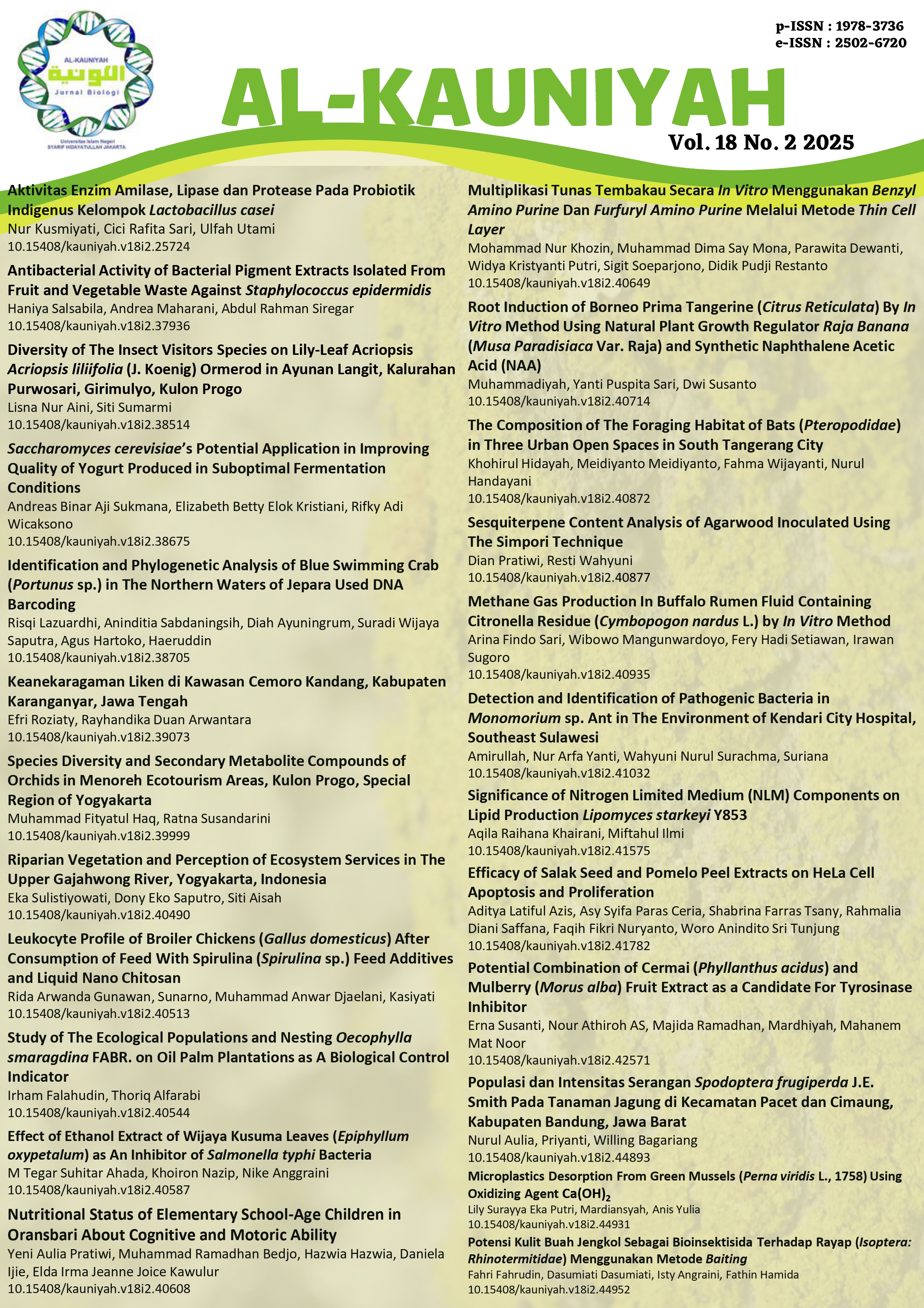The Composition of The Foraging Habitat of Bats (Pteropodidae) in Three Urban Open Spaces in South Tangerang City
DOI:
https://doi.org/10.15408/kauniyah.v18i2.40872Keywords:
Foraging habitat, Pteropodidae, South Tangerang City, Habitat pencarian pakan, Kota Tangerang SelatanAbstract
Pteropodidae bats play an important role in seed dispersal and plant pollination in urban areas. This study aims to identify microclimate factors and forage plant phenology that influence the selection of foraging habitats of Pteropodidae bats in three Green Open Spaces of South Tangerang City. Bat captures were conducted using mist nets placed purposively, for 3 nights with 2 mist nets each in 3 different habitat types. The analysis used was Canonical Correspondence Analysis (CCA) using Canoco software version 4.5. The results found 4 types of Pteropodidae bats, namely Cynopterus brachyotis, Cynopterus horsfieldii, Cynopterus titthaecheilus, and Macroglossus sobrinus. A total of 28 species from 18 plant families were identified that have the potential to be used as food for Pteropodidae bats in South Tangerang City. Based on the results of the analysis using Canonical Correspondence Analysis (CCA), the microclimate factors that influence foraging preferences are the level of disturbance and 3 groups have different tendencies in choosing foraging habitats.
References
Altringham, J. D. (2011). Bats from evolution to conservation. New York, USA: Oxford University Press Inc.
Boonman, A., Bumrungsri, S., & Yovel, Y. (2014). Nonecholocating fruit bats produce biosonar clicks with their wings. Current Biology, 24(24), 2962-2967. doi: 10.1016/j.cub.2014.10.077.
Campbell, P., & Kunz, T. H. (2006). Cynopterus horsfieldii. Mammalian Species, 802(802), 1-5. doi: 10.1644/802.1.
Coles, R. B., Thomson, B. G., Soo, J., Lane, D. J. W., Phibph., & Apong. (2004). Ecological studies of the bat fauna of Brunei Darussalam. New South Wales: The Australasian Bat Society Newsletter.
da Silva, Z. D., Gurgel, E. S. C., Correia, L. L., & Vieira, T. B. (2024). Seed dispersal by bats (Chiroptera: Phyllostomidae) and mutualistic networks in a landscape dominated by cocoa in the Brazilian Amazon. Global Ecology and Conservation, 55(October). Doi: 10.1016/j.gecco.2024.e03252.
Fajri, S. R., Armiani, S., Sukri, A., Kurnianingsih., Maryanto, I., & Afifah, K. N. (2023). Diversity of fruit bats (Pteropodidae) in Nature Tourism Park, Lombok Island, West Nusa Tenggara, (vol. 1). Atlantis Press SARL. Doi: 10.2991/978-2-38476-056-5_13.
Fithria, T. Z., Priyono, B., Setiati, N., & Partaya. (2020). Jenis-jenis kelelawar pemakan buah Subordo Megachiroptera dan sebaran spasial di Kecamatan Gunungwungkal Kabupaten Pati. Bioeksperimen, 6(2), 163-168. doi: 10.23917/bioeksperimen.v5i1.2795.
Greenacre, M., & Primicerio, R. (2019). Multivariate analysis of ecological data multivariate analysis of ecological data is available for free download from the website. Retrieved from https://www.researchgate.net/publication/259890313_Multivariate_Analysis_of_Ecological_Data.
Krishnarathi, A., & Isaac, S. (2016). Food and feeding ecology of bat preferred plant species and their mutualistic interactions in Tirunelveli district. Malaya Journal of Biosciences (MJB), 3(2), 81-90.
Lama, J. M. N., Caballero, E. B., Maceda, J. N., Omandam, J. E., & Mondejar, E. P. (2024). Diversity and distribution trends of bats along elevation and habitat gradients in Mount Tuminungan, Bukidnon, Philippines. Biodiversitas, 25(10), 3728-3738. doi: 10.13057/biodiv/d251035.
Massoud, D., & Abumandour, M. M. A. (2020). Anatomical features of the tongue of two Chiropterans endemic in the Egyptian fauna; the Egyptian fruit bat (Rousettus aegyptiacus) and insectivorous bat (Pipistrellus kuhlii). Acta Histochemica, 122(2), 151503. doi: 10.1016/j.acthis.2020.151503.
Ministry of Home Affairs regulation. (2007). Peraturan Menteri Dalam Negeri nomor 1 tahun 2007 tentang penataan ruang terbuka hijau kawasan perkotaan. Retrieved from https://peraturan.bpk.go.id/Details/126350/permendagri-no-1-tahun-2007.
Ministry of Public Works. (2008). Peraturan Menteri Pekerjaan Umum dan Perumahan Rakyat nomor 5 tahun 2008 tentang pedoman penyediaan dan pemanfaatan ruang terbuka hijau di kawasan perkotaan. Retrieved from https://peraturan.bpk.go.id/Details/285541/permen-pupr-no-5-tahun-2008.
Saridan, A. (2010). Jenis dan preferensi polen sebagai pakan kelelawar pemakan buah dan nektar. Jurnal Penelitian Hutan dan Konservasi Alam, 7(3), 241-256.
Sheherazade. (2014). Distribusi kelelawar pemakan buah (Chiroptera, Pteropodidae) di Kampus Universitas Indonesia, Depok, Jawa Barat (Undergraduate thesis). Universitas Indonesia, Depok, Indonesia.
Soegiharto, S., Kartono, A. P., Besar, P. B., & Samarinda, D. (2009). Karakteristik tipe pakan kelelawar pemakan buah dan nektar di daerah perkotaan: Studi kasus di Kebun Raya Bogor. Jurnal Biologi Indonesia, 6(1), 119-130.
Sritongchuay, T., Hughes, A. C., & Bumrungsri, S. (2019). The role of bats in pollination networks is influenced by landscape structure. Global Ecology and Conservation, 20, e00702. Doi: 10.1016/j.gecco.2019.e00702.
Sudhakaran, M. R., & Doss, P. S. (2012). Food and foraging preferences of three Pteropodid bats in Southern India. Journal of Threatened Taxa, 4(1), 2295-2303. doi: 10.11609/jott.o2227.2295-303.
Suripto, B. A., Zakky, M. K., & Djatmiko, T. (2001). Keanekaragaman jenis kelelawar buah (Megachiroptera) dan pakan alaminya di Kecamatan Kokap, Kulon Progo, Yogyakarta. Berkala Ilmiah Biologi, 2(11), 669-683.
Tan, K. H., Zubaid, A., & Kunz, T. H. (2000). Fruit dispersal by the lesser dog-faced fruit bat, Cnynopterus brachyotis (Muller) (Chiroptera: Pteropodidae). Malayan Nature Journal, 56(1), 57-62.
Wijayanti, F., Humaerah, A. D., Fitriana, N., & Dardiri, A. (2017). Potensi kelelawar sebagai vektor zoonosis: investigasi berdasarkan keanekaragaman jenis dan persepsi masyarakat terhadap keberadaan kelelawar di Kota Tangerang Selatan. Bioma, 12(1), 14. doi: 10.21009/bioma12(1).2.
Wijayanti, F. (2021). Kelelawar di ekosistem perkotaan. Depok: Rajawali Pers.

